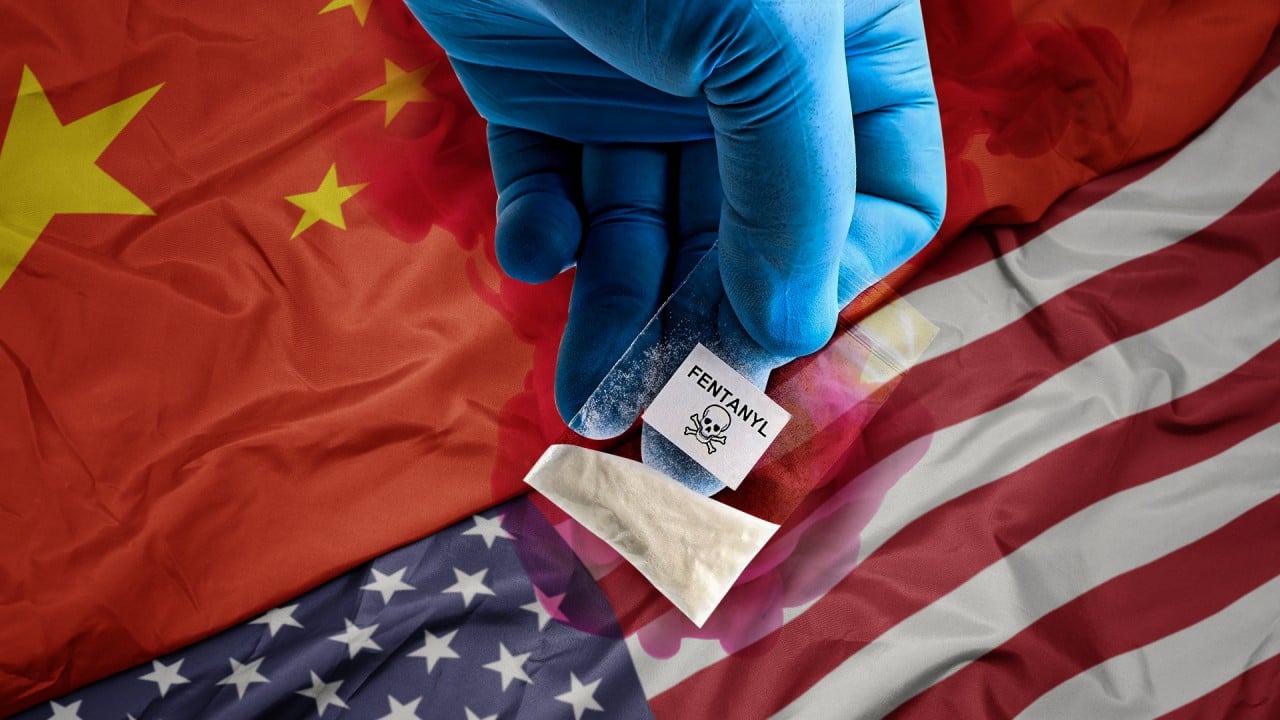Researchers in the United States say they have found a way to greatly strengthen the treatment of fentanyl overdose, a leading cause of death for Americans younger than 45.
The team led by scientists from Washington University in St Louis, the University of Florida and Stanford University published their findings in the peer-reviewed journal Nature on Wednesday.
While the new chemical compound is in its early drug discovery stages, the researchers say it also has the potential to save people overdosing on even stronger opioids in the future.
Fentanyl is a synthetic opioid 50 times more potent than heroin. The US National Center for Health Statistics estimated that almost 75,000 people died from fentanyl overdose in 2023, accounting for almost 70 per cent of drug overdose deaths in the country.
America’s fentanyl crisis has long been a flashpoint in US-China relations. US lawmakers from both parties have criticised China’s role as a primary source for the precursor chemicals that produce fentanyl trafficked into the US, but the administration of US President Joe Biden has been working with Beijing to tackle the issue.
China rejects criticism that it is fuelling the opioid crisis and says the US should tighten its domestic controls “rather than blaming others”.
But in November, Biden and Chinese leader Xi Jinping agreed to work together on narcotics control during their summit in California.
Soon after their meeting, Beijing warned Chinese companies against selling equipment and precursor chemicals that could be used to produce the opioid overseas.
On Monday, US Secretary of State Antony Blinken said that the fentanyl crisis remains an area to cooperate with China.
“Markets are so saturated here that the criminal enterprises that are engaged in this have worked to make markets in other places – in Asia, in Europe, in Latin America.”
China, Blinken added, was “going to have more and more countries insisting that [it engages] responsibly in dealing with this challenge”.
In the study, researchers identified a compound that can increase the potency of the opioid overdose treatment naloxone by more than seven times.
According to the US Food and Drug Administration, naloxone is a life-saving medication that can rapidly reverse the effects of an opioid overdose rapidly. Last year, the agency approved the first naloxone product for use without a prescription under the brand name Narcan.
Narcan is safe and effective, but repeated doses are required to treat overdoses from highly potent and long-lasting opioids, including fentanyl.
To overcome those limitations, researchers in the study found that when used together with the new compound, naloxone’s potency increases more than seven-fold without worsening withdrawal symptoms. The treatment was also found to last longer.
Opioids such as morphine, fentanyl and kratom work by binding to drug-binding “pockets” on neurons in the brain. They activate the opioid receptor, relieving pain and inducing a sense of euphoria but also slowing down breathing.
Breathing can stop from fentanyl overdose and decrease the amount of oxygen that reaches the brain. An overdose can lead to coma, permanent brain damage, even death.
To deactivate the receptor and reserve overdose effects, naloxone – which is also an opioid – is used to displace problematic opioids from the pocket.
The compound, numbered 368, stood out for its ability to bind tightly to opioid receptors only in the presence of naloxone.
Boosted by the new compound, naloxone occupies the pocket for at least 10 times longer and is able to deliver reversal effects at one-tenth the usual dose, the study found.
Jay McLaughlin, a professor of pharmacodynamics at the University of Florida and an author of the study, said that the researchers were committed to finding ways to improve opioid overdose outcomes and reduce deaths.
For the study, his lab tested the new compound on mice.
“If I give a mouse morphine or fentanyl, its breathing rate drops off as much as of the drug I give – typically about 50 per cent,” he said.
“If I give that mouse a little tiny dose of Narcan, it is not enough to reverse morphine and fentanyl-induced respiratory depression.
“But if I give that little dose of Narcan … with our new compound, the Narcan is perfectly effective at blocking that respiratory depression. In other words, we have made Narcan work better to reverse the overdose effect.”

Another author, Susruta Majumdar, a professor of anesthesiology at Washington University School of Medicine, said that the new compound paves the way for an approach that would let scientists develop treatments for opioids more potent than fentanyl – should they appear.
“Since we have built the platform, if not us, somebody else can use this novel drug-binding pocket to improve on Narcan or come up with a long-lasting Narcan-modulated activity,” he said.
“We are ready for any super-potent designer opioids that is coming next with an overdose potential.”
Majumdar said the team would continue to study the compound to improve its penetration and look for other building blocks to make a soluble and stable drug. He estimated that it would take 10 to 15 years for a naloxone-boosting product to reach the market.
Catherine Cahill, a professor in the department of psychiatry and biobehavioral sciences at the University of California Los Angeles, who was not involved in the study, said that the team’s discovery was “an important advance, opening up fresh avenues of investigation in the search for solutions to the opioid crisis”.
In commentary accompanying the study in the journal, Cahill, who studies pain and opioid addiction, said that more research was needed to find out if combining the new compound with naloxone “safely boosts the potency and duration of naloxone in humans”.
“If so, then this would help to combat the devastation caused by opioid addiction,” she added.
Last month, the US House select committee on China set up a policy working group to consider sanctions on entities that are part of the fentanyl trade and closing regulatory gaps exploited by traffickers.
US and Chinese officials also agreed in June to continue regular exchanges between scientists on potential synthetic drugs.



